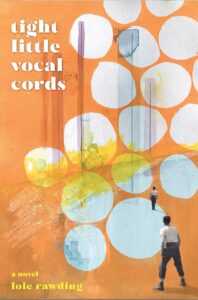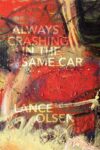
[Kernpunkt Press; 2020]
In an interview for Heavy Feather Review, when asked how she would describe the form of her debut book, Tight Little Vocal Cords, Loie Rawding responds
I absolutely consider this a hybrid novel, a relatively short one at that. There are several forms here: epistolary, script, poetry, and fiction, that work with each other and, at times, against each other. It’s kind of a hot mess! But a carefully curated mess that weaves the journey of my character into a threnody about loneliness, love, and failure to act when we are called to.
If we take the term to signify a work of fiction whose discursive character is not unitary, unrestricted to the kind of expository prose leavened with description and dialogue that has traditionally defined the form, then Tight Little Vocal Cords might indeed be called a “hybrid novel.” Yet “fictional discourse” is not unitary in the first place, since exposition, description, and dialogue themselves are ultimately separate modes that have come to be associated as the “normal” rhetorical practice of narrative fiction only through custom and historical contingency.
Tight Little Vocal Cords encompasses sections written in both prose (from both first and third-person perspectives) and verse, as well as dramatic and epistolary forms (and flashes of what appear to be Morse Code, tapped out by the protagonist). It does not, however, include graphic or other visual elements, the presence of which characterizes the most radically hybrid works, and thus the novel remains an assortment of writing per se, not a multi-media experiment. Although a unifying narrative does ultimately arise from the novel’s various episodic parts, the episodes retain a certain degree of aesthetic independence that makes them more than substitute structural devices for the more familiar devices of plot (nevertheless they do serve as such a device), prompting us to consider such an approach as “hybrid” in the first place.
What, then, distinguishes such a novel as Tight Little Vocal Cords from the very many novels — going back to the very beginning of the form — that assimilate “other” modes of writing: letters, diaries, journals, newspaper reports, extending all the way to the present and the use of digital-era forms to be found in much (presumably non-hybrid) contemporary fiction? Indeed, it seems almost a commonplace to note that the novel actually has no fixed form, has been a hybrid literary genre since the first novels (what we now call novels) were written. Arguably, in fact, the novel has persisted as a literary practice precisely because of its nearly infinite verbal and formal ductility, its capacity to absorb and adapt all other forms of writing for its own artistic purposes, purposes that remain provisional and open-ended. Thus, simply to speak of the “hybrid novel” as a specific category of fiction is neither to specifically define the term in a way that is useful for literary criticism nor to identify something that could be called a recent development.
Even those works that reach beyond writing itself to incorporate visual elements in a more boundary-challenging kind of hybrid work are really logical extensions of the novel’s inherent hybridity, although some writers (Steve Tomasula, say) have gone farther than others in really transforming prose fiction into an alternative medium not confined to purely verbal arrangement. Tight Little Vocal Cords, however, has more modest aims, perhaps to help break down genres of writing into a more amorphous endeavor of “writing,” with the characteristics of both fiction and poetry — or where the distinctions among these characteristics disappear altogether. This does not mean the novel indulges in conspicuous stylistic flourishes or sheerly ornamental language. Although the narrative strategy Rawding uses is indirect and impressionistic in effect, the chronicle of the protagonist’s life that is the object of the narrative still proceeds through incident and scene. The elliptical and fragmented way the story is told acts as an alternate means of enabling the telling, but much of the writing continues to perform the expository function intrinsic to most narrative fiction.
The protagonist of Tight Little Vocal Cords is known to us simply as M. Rawding has said that her novel has its origin in a consideration of the life and work of the painter Marsden Hartley, but although he does appear to share some biographical attributes — the trajectory of his life is roughly analogous — M is not Hartley. Most overtly, M is not a painter. Still, he does in a sense follow in Hartley’s footsteps in his journey out of a bleak childhood in coastal New England, to a free-spirited period spent in Europe, and back to New England. Rawding seems to have endowed M as well with Hartley’s somewhat equivocal sexuality. Over the course of the novel he is depicted in sexual relationships with both men and women (although his great love is, like Hartley, for a German soldier), an uncertainty that reflects a broader provisional quality to M’s experience: at first the novel would seem to be developing into a picaresque coming-of-age story of sorts, as M escapes the grim conditions of his youth after the death of both of his parents (his mother dies early in the book, in a flash-fiction episode that may have been the genesis of the novel, evoking a Hartley painting) and immediately embarks on a cross-country trip, winding up in the desert West.
Although M subsequently travels halfway around the world before coming back to where he began, it cannot be said that he appears to have gained some essential wisdom or completed a journey of self-discovery. In fact, at the novel’s conclusion M is again on his way to parts unknown (he may be returning to the desert in a version of the eternal recurrence), the narrator remarking that “We leave him to search for his self again,” making explicit that his story has not reached a conventional resolution. At this point, the narrative “We” is an imaginary assemblage of sailors purporting to occupy M’s mind and with whom M interacts in the final pages of the novel. Whether this is to be taken as an ominous sign of M’s mental instability or as perhaps lingering evidence of his past that he still must leave behind is not entirely clear, although perhaps both of these perspectives are true to an extent.
Yet this uncertainty about M’s state of mind underscores what may be the novel’s most serious weakness, one that its discontinuous formal method exacerbates, however much it also constitutes the medium by which such a character is possible in the first place. Ultimately M is a less interesting character than the aesthetic and emotional ministrations provided him suggest he should be. While other characters come and go — including his parents in the novel’s first section — M is the almost exclusive subject of attention throughout, and we never really get close enough to him or share his emotional responses to find his plight particularly urgent or his behavior especially affecting. The novel’s middle section, set in Weimar Germany, is narrated by the soldier (who is AWOL), and while the focus is ostensibly on M and his further attempts at self-discovery after leaving the desert, the soldier (unnamed, but referred to playfully by his friends as “Yin-Yang”) emerges from the episode as a far more dynamic character than M. Certainly being given the first-person narration for an extended portion of the novel (an opportunity not afforded to M at any point) contributes to the added depth and color of this character, but, here and elsewhere in the novel, M remains sufficiently removed, an object of observation and contemplation, that he seems too much like a specimen under examination.
To this extent, M seems like a character being used for illustrative purposes. He exemplifies sexual (if not gender) fluidity. His quest is to achieve self-actualization through satisfying his sexual impulses, yet his self appears so thoroughly mutable, it seems likely it will be a quest without completion. Perhaps this is the point — to suggest that human desire is elastic and infinitely variable. But then Tight Little Vocal Cords becomes a novel that has a point, to which the main character has been made more or less subordinate. M is not portrayed as beyond criticism or disapproval. He can be callous in his treatment of others and is often enough inattentive, and thus the novel is not an unqualified celebration of his non-heteronormative behavior. Nevertheless, it does ultimately present M’s experiences as authentic and beneficial expressions of his inner nature, and it would not be distorting what seem to be its ambition, at least thematically, by saying that it works to a significant degree as an instrument for affirming these experiences.
Undoubtedly many readers would find this a wholly worthwhile project, ample justification for any work of fiction. Isn’t the putative warrant for reading fiction that it provides us access to multifarious experiences, especially those different from our own? However, it seems to me that this novel itself undermines the notion that its value should be attributed primarily and most importantly to its status as a vessel for a character’s immediate experience. Surely a more direct representation less dependent on artifice would be the more expedient means of relating M’s activities and perceptions. Not only has Rawding chose to render “experience” through a work of fiction, already a displacement of life as lived and therefore less trustworthy as a conduit to reality, but the novel she has written is formally intricate enough that it threatens to seem entirely superfluous to the goal of simply communicating the protagonist’s experience. This intricacy is in fact the most compelling feature of Tight Little Vocal Cords, one that has little to do with whether we want to call it a “hybrid novel” or not. The formal imagination evinced counterbalances any lack of charisma in the main character, and this resourcefulness, at the very least, should not be disregarded in considering the contribution of a work such as this.
Daniel Green is a literary critic whose essays and reviews have appeared in a variety of publications, both online and in print. His new book, Beyond the Blurb, has just been published by Cow Eye Press and his website can be found at: http://noggs.typepad.com.
This post may contain affiliate links.






